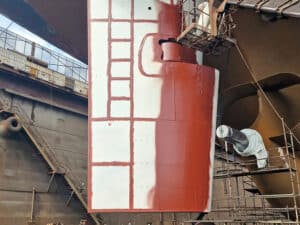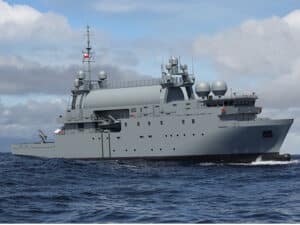
China buys license to build new LNG containership family
Written by Nick Blenkey JUNE 6, 2013 — Chinese shipbuilders could soon be using German technology to take a lead in the production of LNG fueled containerships. Hamburg headquartered Technolog GmbH has sold China’s SUMEC Marine Company Ltd. licenses for the manufacture of a family of LNG-fueled containerships with capacities ranging from 3,500 TEU to 5,000 TEU. State-owned SUMEC will now promote the design to the top ten shipbuilders in Jiangsu province.
JUNE 6, 2013 — Chinese shipbuilders could soon be using German technology to take a lead in the production of LNG fueled containerships. Hamburg headquartered Technolog GmbH has sold China’s SUMEC Marine Company Ltd. licenses for the manufacture of a family of LNG-fueled containerships with capacities ranging from 3,500 TEU to 5,000 TEU. State-owned SUMEC will now promote the design to the top ten shipbuilders in Jiangsu province.
Named STREAM — standing for Sustainable Transport, Reliable, Economic and AMbitious — the containership family has been developed, over a number of years, by Hamburg engineering association IPP (Ingenieur Partner Pool GmbH).
Technolog says the design of the STREAM ships meets all future IMO requirements and reduces carbon dioxide emissions to be reduced by more than 30 percent in comparison with the most recently delivered new ships of a similar size.
“This contract shows that in developing LNG-powered STREAM containerships we made the right choice at the right time,” says Hans-Jürgen Voigt, Managing Director of Technolog.
In addition to reduced carbon dioxide emissions, the STREAM ships also have a very much reduced output of nitric oxide (NOX) and sulfur oxide (SOX) gases.
The STREAM containerships have a new container storage system that dispenses with hatch covers. The hull form has been optimized to achieve the maximum container or project payload, while keeping fuel consumption to a minimum.
The fueling system can use either fixed or mobile tanks or a combination.
The patented hatchless container storage system has a stopper element that absorbs the weight of the upper container layers, so that the pressure on the lower containers does not become excessive and cause container collapse. Technolog says that this means that container tiers can be piled twice as high as in the past, even without the help of cell guides. The system makes it possible for standard 20 or 40 foot containers to be loaded or unloaded one stack at a time, and containers of abnormal width or length (including 45, 48 and 49 foot units) can be handled with equal ease. This avoids the expense of cargo relocation when in harbor, and so shortens the length of a ship’s stay in port to a significant degree. A special ventilation system enables nearly all 40-foot slots in the hold and up to three layers on deck to be used to stow refrigerated containers.
With its dual fuel main engine, the ship can run either on traditional heavy fuel oil (HFO) or on environmentally friendly LNG. When LNG is used exclusively, sulfur oxide emissions can be almost completely eliminated. As a result, the new ship’s design already meets all future IMO emission requirements of the International Maritime Organisation, and it also comes well below the mandatory limiting values for the emission of nitric oxides and sulphur oxides.
In 2016 the third phase of the IMO’s emission regulations, IMO Tier III, comes into force. The new standard calls for drastic cuts in nitric oxides (NOX) in the North Sea and Baltic areas subject to heavy marine traffic which have been designated as Emission Control Areas (ECAs) – a reduction of up to 80 percent as compared with IMO Tier I. The sulfur content of fuel in ECAs is likewise to be cut once more in 2015 from 1 percent to 0.1 percent, while from 2020 onward the sulfur content for maritime traffic will be restricted to 0.5 percent worldwide.
Technolog says that all mechanical systems have been intelligently coordinated so as to result in significantly reduced fuel consumption. For example, the main engine not only generates the necessary propulsion power but also provides all the electricity that is needed on board. A waste heat recovery system (WHRS) meanwhile obtains additional energy from the exhaust, resulting in an even higher degree of efficiency.
The propulsion system on board has been optimised for economical operation at speeds ranging from 14 to 18 knots, but at the same time it allows for catch-up speeds of up to 21 knots or more. Depending on the type and size of vessels, fuel savings will be between 30 and 40 percent in comparison with the most recently delivered new ships of a similar category. Compared with a “conventional” new ship, a STREAM container vessel with a capacity of 5000 TEUs will be able to save well over 500,000 tons of CO2 emissions in the course of its lifecycle.
Acting as IPP’s sales and marketing partner, Technolog will supply the design as a complete blueprint for construction along with the LNG drive technology
Nanjing based SUMEC Marine Company Ltd. is a subsidiary of the SUMEC Group Corporation and is a major state-owned company specializing in shipbuilding, ship conversion, shipowning and marine technology.
SUMEC is one of the leading shipbuilding contractors in China and will be responsible for the exclusive promotion of the STREAM design in the ten top shipyards in Jiangsu Province:
- Jiangsu New Yangzi Group (including New Yangzijiang Shipyard, Xing Fu and Changbo)
- New Century and New Times Group
- Sinopacific Group (including Da Yang and Zhejiang Shipyard)
- Jingling Shipyard (including Nanjing and Yizheng)
- Hantong Heavy Industry (including New Hantong in Yangzhong and Hantong Shipyard in Nantong)
- Taizhou Kouan Shipbuilding Co. Ltd. (including New Yard)
- Taizhou Sanfu Shipyard
- Jiangdong Shipyard in Wuhu
- Chengxi Shipyard in Jiangyin
- China Shipping industry (Jiangsu) Co. Ltd.





Leave a Reply
You must be logged in to post a comment.